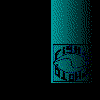












How to compose a fishpopulation for a community-tank
At the composition of the population for a architectonic community-tank
the next considerations are relevant. We guarantee a good quality of life:
1. By not putting to many fishes in the aquarium. A good planted and flourishing
tank can manage the pollution of ca 1 gram fish on 3 liters of water. Content
of this tank (see actual vivarium ) : 16
x 7 x 7 = 784 liter. Diminished with 5% for the bottom and empty room in the top
of the tan, rest 610 liters : 3 = 200 grams of fish
2. By choosing fishes
that come from he same milieu
3. By keeping social fishes in company of enough
other fishes. To create a good communityfeeling we put together at least 11 fishes
of one kind.
We try to create a attractive population, a population on which we can get some
new experiences. Therefore we take care that fishes live in every layer of the
water, on top in the mid and at the bottom.
We take care of various shapes
and color of the fishes. Also some variety in the way of life raises the charm.
Excepting the Leeri's we choose for predominant little fishes; that increases
the possibility's without overpopulating the tank.
Actin so we get the following
assamblation:
Surface: 1: 5 x Trichogaster leeri 2 males and
3 females. The males that will be in competition with each other because of the
females will show the most beautiful colors, and three females will be better
proof against the advances of the males than two (75 grams)
2: 7 x
Aplocheilus panchax 3 males, 4 females (35 grams)
Mid...5:
15 x Megalamphodus sweglesi 6 males, 9 females; It is better to put
together more females with less males, because a mating couple will be disturbed
by the jealous males (45 grams)
10 x Otocynclus affinis, that
will zealously fight the algae if they exist (20 grams)
Bottom:.3:
4 x Tateurndina ocellicauda Colorful and interesting habitants of the
bottom (8 grams) and 4: 2 x Rhinogobius wui (6 grams) (An art gobius
that lives as a couple and is a cave breeder) These will make that things will
happenat the bottom of the tank.
In total 189 grams
The picture above
shows clear the differences in color an form. Also is evident that all layers
of the aquarium are populated and there is rather much variation in behavior.
Mind only the building of a nest of foam of the leeri's, het territorial fights
of the gobius. The Otocynclus, who lives a rather "hidden" life is not
at the picture.